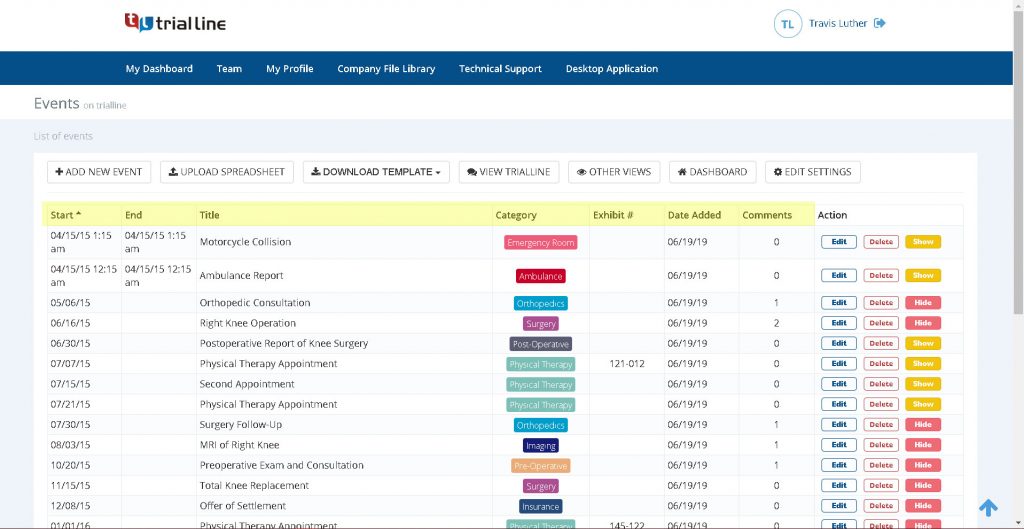On June 22, 2023, a remotely operated vehicle captured haunting footage of the OceanGate Titan submersible’s wreckage, revealing a shattered aft titanium dome and a tail cone bearing the company’s logo. Released by the Coast Guard in September 2024, these videos mark a grim milestone in the tragic saga of the Titan – a journey from innovative ambition to catastrophic failure.
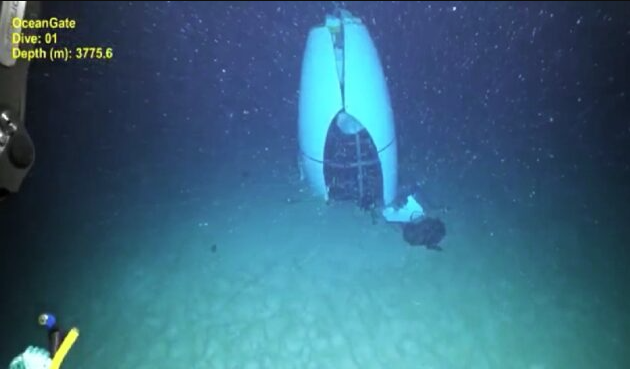 (Photo: Pelagic Research Services via U.S. Coast Guard)
(Photo: Pelagic Research Services via U.S. Coast Guard)
In September 2024, the Coast Guard held a public hearing to investigate the implosion’s cause, fueling global discussions on the risks of private underwater exploration. Let’s review the timeline of OceanGate’s Titan sub through our legal timeline software to know what may have contributed to such a controversial incident.
(Click Here to View Full Timeline)
What Happened to The Titan?
On June 18, 2023, the Titan, a submersible operated by OceanGate, imploded during an expedition to the Titanic wreck in the North Atlantic Ocean near Newfoundland, Canada. Onboard were French explorer Paul-Henri Nargeolet, British billionaire and adventurer Hamish Harding, Pakistani businessman Shahzada Dawood, his son Suleman, and OceanGate CEO Stockton Rush, who piloted the 22-foot vessel.
The U.S. Navy detected sounds “consistent with an implosion” on June 18, shortly after the sub lost contact at 9:45 AM during its descent to the Titanic, 3,800 meters (12,467 feet) below sea level.
What caused the implosion?
The Titan’s hull is believed to have collapsed due to immense deep-sea pressure.
Made from carbon fiber and titanium— materials considered capable of withstanding pressures at depths up to 4,000 meters— the sub’s hull was designed to shield the crew from underwater pressure. At the Titanic wreck site, 3,800 meters down, the water pressure is approximately 400 atmospheres (6,000 PSI), equivalent to the weight of about 35 elephants pressing on your shoulder.
However, experts, including deep-sea engineer Eric Fusil, have raised concerns about using titanium and carbon fiber together in deep-sea vessels due to their differing properties. Titanium is elastic, allowing it to endure varying stress and pressure without permanent damage, whereas carbon fiber is stiffer and non-elastic, making it more prone to cracking.
Eric Fusil, writing for The Conversation, speculated that the difference between the materials could have created a flaw in the hull leading to an “instantaneous implosion due to underwater pressure.” He wrote, “Within less than one second, the vessel — being pushed down on by the weight of a 3,800m column of water — would have immediately crumpled in from all sides.” Testimonies from the 2024 Coast Guard hearing later revealed flaws in the carbon fiber hull and inadequate maintenance, further explaining the catastrophic failure.
The Foundation of OceanGate
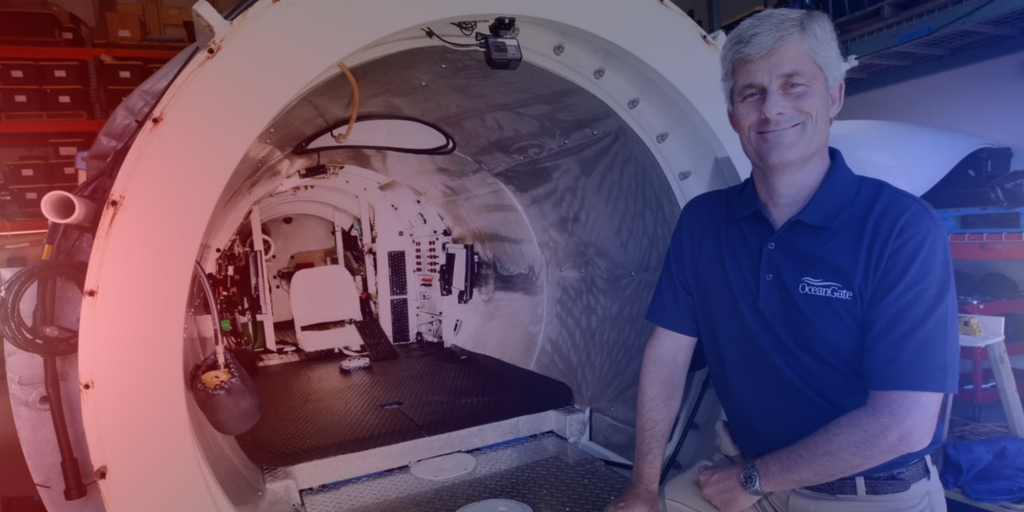
2009: OceanGate is founded
According to company news releases, OceanGate, a provider of manned deep-sea submersibles, began its operations on the West Coast. Its founder, Stockton Rush III, graduated from Princeton University in 1984 with a BSE in aerospace, aeronautical, and astronautical engineering, and later earned an MBA from the University of California Berkeley’s Haas School of Business in 1989, as noted in his biography on OceanGate’s website.
February 2012: OceanGate expands operations to Florida and the Caribbean
The company is registered as a corporation in Miami, with Guillermo Sohnlein serving as president and Rush as secretary. According to official documents, it was incorporated in Washington State in December 2011.
Project Cyclops I
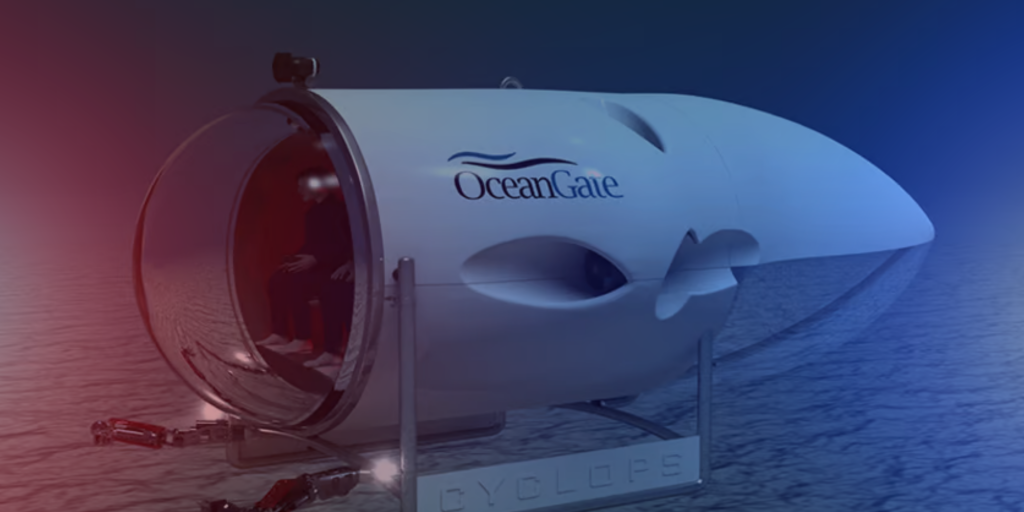
May 2013: Collaboration announced with the University of Washington
OceanGate announced that it collaborated with the University of Washington’s Applied Physics Lab on Project Cyclops I, a 3000-meter 5-person submersible.
(On June 23, 2023, the University of Washington clarified that they only completed about $650,000 worth of work on a $ 5 million research collaboration agreement before parting ways. The collaboration resulted in a steel-hulled vessel that can only travel to a depth of 500 meters.)
June 2013: Research on invasive fish species
OceanGate partners with Nova Southeastern University to research invasive lionfish in Florida.
August 2013: Submersible feasibility study concludes
OceanGate announces that the University of Washington has completed a feasibility study for the hull design of the Cyclops I submersible.
June 2015: Report was released on submersible
Rush and Science and Technology Director Erika Montague and University of Washington engineer Peter Brodsky published a report on the Cyclops I submersible.
Starting the Expeditions
November 2015: The first paying customers begin signing up for the expedition
Marc and Sharon Hagle signed a contract and placed $10,000 in deposits with OceanGate to join an expedition to the Titanic.
It is worth noting that the Hagles became the “first married couple on a commercial space flight” when they launched aboard Bule Origin’s 20th New Shepard rocket flight on March 31, 2022.
June 2016: OceanGate submersible dives into a wreck
One of the company’s submersible conducts a dive over the wreck of the Andrea Doria near Nantucket.
March 2017: OceanGate announces upcoming Titanic dive
The company announces plans to conduct the first manned submersible dives to the Titanic since 2005, offering private citizens the opportunity to join the expedition as mission specialists for $105, 129 each.
August 2017: One step completed
OceanGate finalized the assembly of the core pressure vessel by bonding two titanium rings to the end of a carbon-fiber cylinder that is 56 inches wide and 100 inches long.
September 2017: OceanGate postponed the Haggles trip and refused to issue a refund
After the launch date of the submersible expedition was postponed, Marc and Sharon Hagle contemplated requesting a refund.
Rush held a meeting at the Hagle residence to keep them engaged in the expedition. He reassured the couple by providing a thorough explanation of the different aspects of the dive and the vessel.
In February 2023, the couple filed a lawsuit against Rush, claiming fraudulent inducement and a violation of Florida’s Deceptive and Unfair Trade Practices Act.
Project Cyclops 2, The Titan
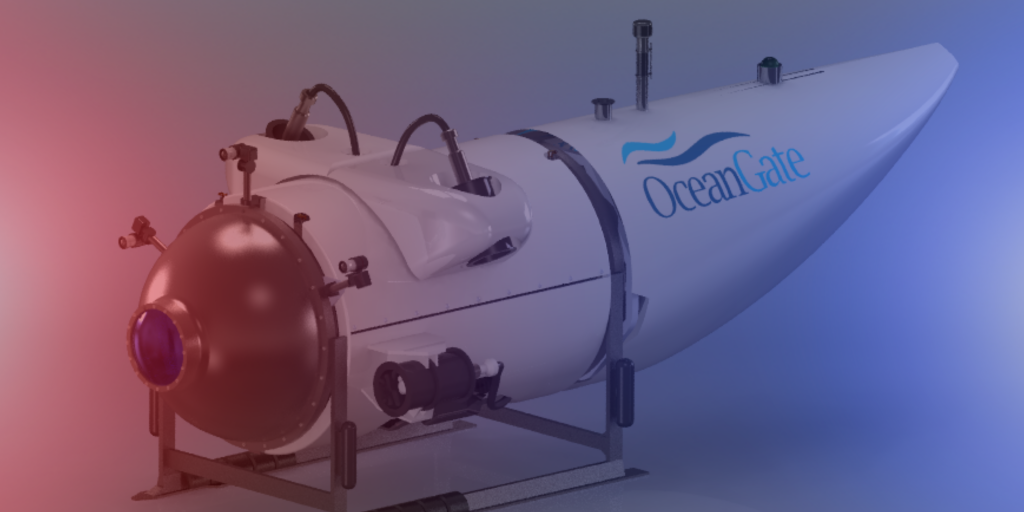
January 2018: Launch and recovery testing
OceanGate tweets that it has successfully tested the launch and recovery platform for Cyclops 2.
February 2018: Cyclops 2 becomes the Titan
The engineering team transfers Cyclops 2 to the operations team and renames the submersible.
The Hagles wire an additional $190, 258 to cover the costs of their upcoming Titan expedition.
March 2018: Safety issues raised
The Marine Technology Society, a trade group, sent a letter to OceanGate, expressing unanimous concerns about the development of the Titan submersible and its planned expedition to the Titanic.
April 2018: Expedition called off
The Hagles state that Oceangate has canceled the expedition originally set for 2 to 9, 2018, and has rescheduled it for July 2019.
July 2018: Lawsuit emerges
OceanGate filed a lawsuit against former Director of Marine Operations David Lochridge and his wife, Carole Reid Lochridge, in Washington State.
The lawsuit alleges breach of contract, including violations of his employment agreement by sharing confidential information with other employees and representatives from the Occupational Safety and Health Administration (OSHA).
August 2018: Safety concerns
The Lochridges filed a counterclaim in the lawsuit, raising several safety concerns regarding the Titan submersible.
During his testimony in the court hearing, Lochridge stated, “The whole idea behind the company was to make money. There was very little focus on science.”
November 2018: Case dismissed
The parties reach a statement in the Ocean Gate v. Lochridge case.
Lochridge explained that, as part of the settlement, he signed a non-disclosure agreement instead of paying OceanGate money. He could not speak openly about his employment until the Coast Guard subpoenaed him.
Pursuing a counterclaim “was going nowhere”, Lochridge said, adding that he and his wife realized, “it was causing more harm to us.”
December 2018: A new milestone
CBS This Morning reports that Rush reached a depth of 13,000 feet during a dive in the Titan submersible in the Bahamas, marking a significant milestone in his plan to explore the Titanic in 2019.
Multiple Delays
April 2019: A new patent
The United States Patent Office grants Ocean Gate a patent for systems designed to recover objects in aquatic environments.
October 2019: Expedition canceled
The Hagles receive an email notifying them that OceanGate has canceled the 2020 expedition.
January 2020: Raising funds
OceanGate announces that it has secured $18 million in equity financing, which will be used to expand its fleet of deep-sea submersibles in preparation for dives to the Titanic in 2021.
February 2020: Collaborating with NASA
NASA announces its partnership with OceanGate to develop and manufacture new carbon fiber pressure vessels.
On June 23, NASA informed USA TODAY that it “consulted on materials and manufacturing processes for the submersible.” Lance Davis, acting news chief for the Marshall Space Flight Center, stated that the agency “did not conduct testing and manufacturing via its workforce or facilities, which were done elsewhere by OceanGate.
The Titanic Expeditions
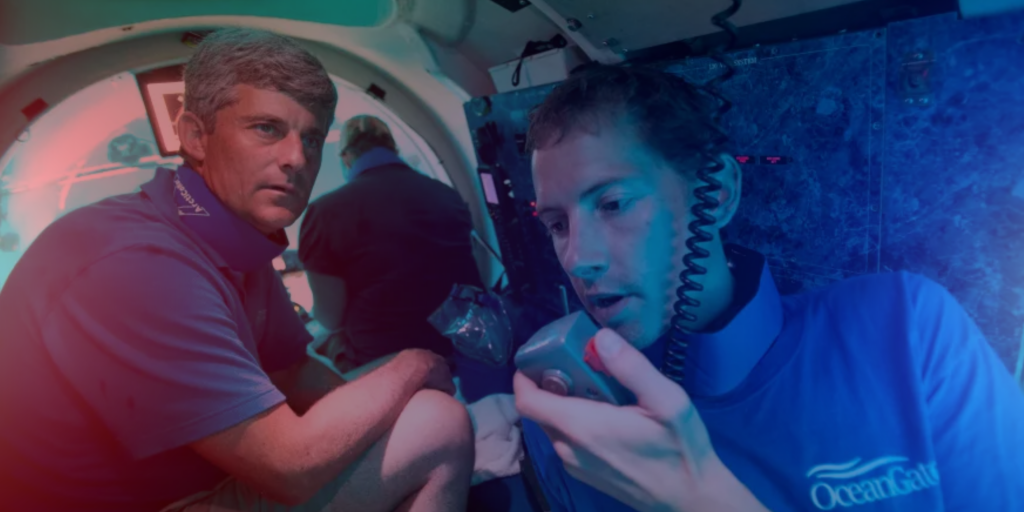
November 2020: Starting the tourist dives
Numerous international news outlets report that OceanGate will begin its first tourist dives to the Titanic in 2021.
March 2021: Astronaut joins expedition
OceanGate announced that NASA astronaut and physician Dr. Scott Parazynski will participate in the Titanic expedition.
Dr. Parazynski, a veteran of five spaceflights, is known for his extensive experience in both space exploration and medicine. He has performed numerous spacewalks and is the only astronaut to have reached the summit of Mount Everest. His expertise in extreme environments and his background as a physician make him a valuable addition to the expedition team.
May 2021: OceanGate submits plans to federal regulators
The U.S. District Court manages legal matters related to the Titanic under an ongoing 1993 court case. In May 2021, David Concannon, a legal and operations consultant for OceanGate, sent a letter to the court detailing the expedition plans, stating that it would be “the first of many” and would adhere to NOAA guidelines.
“The exploration team will conduct annual surveys of the wreck in collaboration with scientific and imaging experts from multiple organizations as part of an ongoing long-term study to document the current condition of the Titanic maritime heritage site.”
The letter assured the court that the vessel would not disturb or retrieve any artifacts and would not place any ballast “well clear of the wreck and the debris field.” It concluded with an invitation for the judge to join the expedition as a guest of OceanGate.
June 2021: Another patent
The United States patent granted OceanGate for systems and methods for launching and recovering objects in aquatic environments.
July 2021: Titanic success
OceanGate completed its first submersible dive to the Titanic with a team that includes Rush, Scott Griffith, and PH Nargeolet, a former French naval commander and submersible pilot. The company states that a series of annual expeditions will help document the Titanic’s rate of decay and map the artifacts located at the site.
September 2021: Patent for monitoring integrity
OceanGate is granted a patent for systems used in curing, testing, validating, rating, and monitoring the integrity of composite structures.
November 2021: Tickets available for the next expedition
OceanGate announces its 2022 expeditions to the Titanic, with the ticket price increasing to $250,000.
May 2022: OceanGate provides the court with an update on its expedition plans
OceanGate submits a letter to the District Court informing it of plans for five photographic and scientific survey “missions” to the Titanic wreck site during the summer of 2012, along with a draft of its science plan.
“Every effort will be made to avoid contact with the wreck itself, and no artifacts or scientific samples will be collected from the wreck itself. However, this year the expedition does plan to take free-floating water samples throughout the water column and on the bottom, as part of OceanGate’s scientific efforts to collect environmental DNA in conjunction with its partners at the University of North Carolina and the University of Edinburgh.”
July 2022: Expedition encounters difficulties
CBS correspondent David Pogue participates in a Titanic expedition with OceanGate. During one of the dives, the submersible fails to locate the Titanic.
“We were lost,” said Shrenik Baldota.” We were lost for two-and-a-half hours.”
August 2022: A footage of the dive is released
OceanGate releases high-definition footage from its 2022 expedition to the Titanic.
“In comparing footage and images from 2021, we do see slight changes in certain areas of the wreck,” said Stockton Rush in the release. “ Our science team will be reviewing the 8K, 4K, and other footage captured during the 2022 Titanic Expedition for changes. Having experts aboard the Titan submersible when we dive allows them to assess the shipwreck through direct observation, guide our exploration of different features of the wreck, and continue their study using the imagery.”
February 2023: Couple accuses OceanGate of fraudulent inducement
The Hagles file a lawsuit against Rush in Orange County, Florida Circuit Court, accusing him of fraudulent inducement and violating Florida’s Deceptive and Unfair Trade Practices Act.
Marc and Sharon Hagle accuse Rush of misleading them about their trip to visit the Titanic wreck and refusing to refund their money when they decided to withdraw, despite assurances that they could receive a refund.
April 2023: OceanGate sends 2023 plan to court
Concannon sends a letter to the District Court stating that the 2023 expedition will start in early May and continue in 8-day segments until the end of June.
“Each dive will involve deploying the 5-person submersible, Titan, which has a depth of 4,000 meters (13,120 feet) with a comfortable safety margin. Constructed from titanium filament-wound carbon fiber, the innovative vessel has proven to be a safe and reliable option for withstanding the immense pressure of the deep ocean,” the letter explains.
The scientists and archeologists involved in previous dives “are currently compiling and analyzing their findings.” The company and research team worked with eDNAtec, based in St. John’s Newfoundland, to study the environmental DNA from water samples collected near the wreck and nearby natural reef. This collaboration will continue in 2023 with eDNAtec planning to make all gene sequences available through GenBank once their analysis is complete.
May 26, 2023: Titanic expedition underway
OceanGate Expeditions shares a photo of 24 people on deck via Twitter, stating, “It’s been an exciting week with our Mission 2 crew!”
June 1, 2023: In the ‘middle of North Atlantic’
OceanGate Expedition tweets “Despite being in the middle of North Atlantic, we have the internet connection we need to make our #Titanic dive operations a success- thank you @Starlink!”
June 17, 2023: Harding posts dive planned the next day
Hamish Harding, chairman of Action Aviation, shares on Facebook that he has joined OceanGate Expeditions for the Titan mission and is scheduled for a dive attempt on June 18.
Titan Submersible Disaster
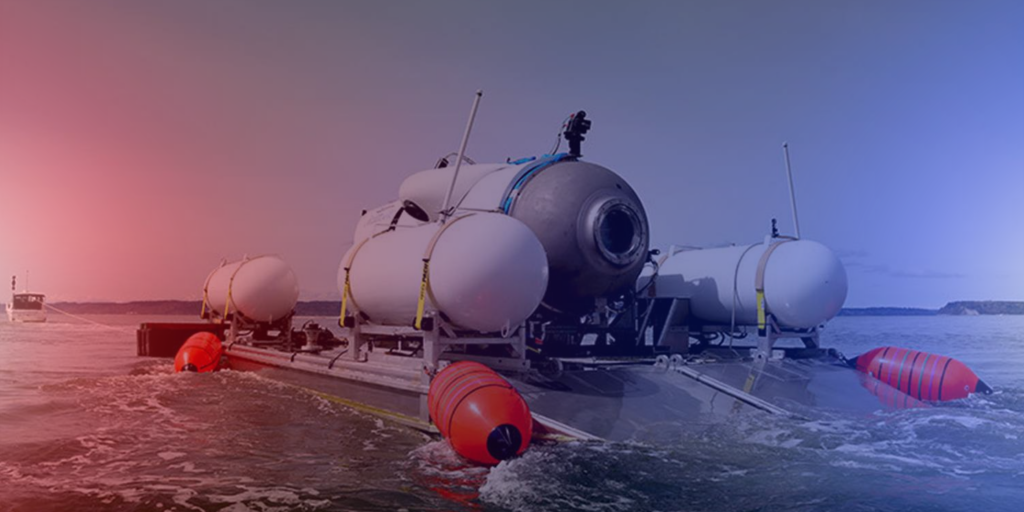
June 18, 2023: Day ends in disaster
8:00 AM: Titan begins its descent from the Canadian research vessel Polar Prince to the Titanic wreck, a journey that the U.S. Coast Guard estimates will take two hours to reach the ocean floor.
9:45 AM: Communication between the Titan and its mothership stops approximately 90 minutes into the journey.
Unknown time: Navy acoustic equipment identifies an “anomaly” in the area near the site.
3:00 PM: The Titan fails to surface at the expected time.
5:40 PM: The Coast Guard receives a report regarding an overdue 21-foot submersible, carrying five people, that was diving to see the wreckage of the Titanic, located approximately 900 nautical miles east of Cape Cod.
June 19, 2023: Search underway
The Coast Guard states that one of its C-130 Hercules aircraft and crew, along with a Canadian P-8 aircraft equipped with underwater sonar capabilities, are searching the submersible.
June 20, 2023: Hope flares
The Canadian aircraft reports detecting “underwater noises in the search area.”
The Coast Guard sets up a command center to coordinate the efforts of multiple vessels involved in the search operation, noting that 10, 000 square miles have already been covered. This includes a Bahamian research vessel employing a remotely operated vehicle and another C-130 crew. The Coast Guard also reports that eight vessels are en route, comprising five Canadian ships, a French research vessel, the motor vessel Horizon Arctic, and the commercial vessel Skandi Vinland.
June 21, 2023: Search efforts continue
The Coast Guard announces that a third C-130 is on its way, along with a Magellan ROV. The Navy is also dispatching experts and a Deep Ocean Salvage System intended for lifting underwater objects.
June 22, 2023: Debris field located
At 11:45 AM, the Coast Guard reports that an ROV from the Horizon Artic has located a debris field near the Titanic, likely resulting from a catastrophic implosion.
OceanGate confirms that the crew of the Titan is lost.
June 23, 2023: Lawsuit dropped
The Hagles, who made history as the first married couple to embark on a commercial spaceflight in 2022, withdrew their lawsuit. They express, “Money is a driving force in our economy, but honor, respect, and dignity are more important to the human soul.”
June 24, 2023: Canada to launch an investigation
Canada’s Transportation Safety Board announces it will investigate the Polar Prince, the mothership of the Titan, which is owned by Horizon Maritime. This company also owns the Horizon Arctic, the vessel whose crew discovered the wreckage of the Titan.
June 25, 2023: Coast Guard joins the investigation
The Coast Guard announces that its Marine Board of Investigation will spearhead the inquiry into the loss of the Titan, Captain Jason Neubauer, the chairman of the MBI, states a recommendation to enhance safety in the maritime sector globally.”
June 28, 2023: Titan debris recovered
The Horizon Arctic vessel returns parts of the Titan to shore in St. John’s, Newfoundland. Following a discussion with international partners, the Coast Guard plans to transport the evidence to a U.S. port for additional analysis and testing. A press release states that medical professionals will perform “a formal examination of presumed human remains that have been meticulously retrieved from the wreckage.”
July 2, 2023: OceanGate shuts down
OceanGate Expeditions updated its website to announce the cessation of its operations. The company has suspended “all exploration and commercial activities” following the fatal implosion of its submersible.
The tragedy claimed the lives of OceanGate CEO Stockton Rush, British billionaire and explorer Hamish Harding, French Titanic expert Paul Henri-Nargeolet, and Pakistani businessman Shahzda Dawood along with his son, Suleman Dawood.
The notice of the suspended operations was prominently displayed at the top of the company’s website.
Takeaways From OceanGate’s Public Hearing
The U.S. Coast Guard’s public hearing on the Titan submersible disaster took place from September 16 to 27, 2024, at the Charleston County Council Building in South Carolina. The goal was to uncover the facts behind the incident and recommend measures to prevent future tragedies. The findings from this hearing are expected to provide a definitive cause of the accident and shape new regulations for deep-sea diving, as well as guide criminal and administrative investigations on the case.
Key testimonies during the hearing highlighted possible issues with the Titan submersible before the expedition:
- A former U.S. Coast Guard member testified that the “first alarm bell” was OceanGate’s sudden severing of ties with the Applied Physics Lab at the University of Washington. The “second alarm bell” was Boeing’s refusal to supply the carbon fiber for the first hull.
- McCoy, who raised concerns in 2017 about the lack of certification for Titan, said OceanGate CEO Stockton Rush’s response was that he would “buy a congressman” to resolve any issues.
- John Winters testified that Rush often expressed frustration with regulations, claiming they stifled his innovation.
- Dr. Don Kramer, an engineer with the National Transportation Safety Board, stated that the sub’s carbon fiber hull showed flaws, while Kohnen testified that repeated dives weakened the material.
- Amber Bay, OceanGate’s former director of administration, recalled that when a former employee raised safety concerns, Rush asked her to fire the employee for “erratic, unprofessional behavior.”
- Karl Stanley described multiple “red flags,” including Rush’s lack of confidence in the sub, strange noises, and his reluctance to operate the vessel.
- OceanGate co-founder Guillermo Sohnlein, who left in 2013 when it became clear OceanGate wanted to transition to engineering, lamented, “This wasn’t supposed to happen. Five people should not have lost their lives.”
- A transcript of a meeting between Rush and former marine operations director David Lochridge revealed that Lochridge had voiced safety concerns.
- Roy Thomas, a senior principal engineer at the American Bureau of Shipping, outlined the challenges of carbon fiber, which is not approved for vessel classification. He also pointed out that improper storage may have led to material degradation.
- Former OceanGate engineering director Phil Brooks testified that no maintenance was done on the Titan’s hull between 2022 and 2023.
- Fred Hagen, a witness, stated that anyone who felt safe diving in Titan was “delusional,” describing it as an experimental and dangerous vessel.
- Dave Dyer from the University of Washington claimed that the carbon fiber hull design was incomplete.
- Patrick Lahey, CEO of Triton Submarines, questioned the classification of Titan in 2019 and criticized its execution, describing some elements as “amateurish.”
- Reneta Rojas, who participated as a “mission specialist,” clarified that it was a volunteer role, despite her lack of oceanography experience.
- Former OceanGate employees Tony Nissen, Bonnie Carl, and Tym Catterson testified that there was “100 percent” pressure to get Titan into the water. Carl confirmed that Lochridge had deemed the vessel “unsafe.”
Timeline of OceanGate’s Titan Sub with TrialLine (Click Here to View Full Timeline)
As investigations into the Titan tragedy continue, this incident will serve as a pivotal case for both the scientific and maritime communities. To help track key events, we’ve created a detailed timeline of OceanGate’s Titan sub using TrialLine, a legal timeline software.
Want to learn more about TrialLine and how it can assist you in reviewing important case timelines like this? Sign up for free today and schedule a demo with one of our experts to discover how you can create customized timelines for your needs.




